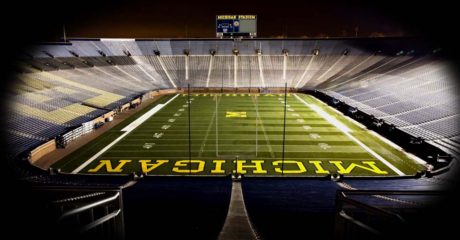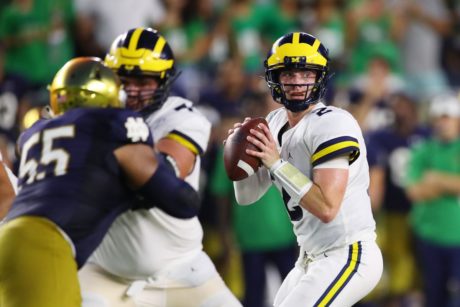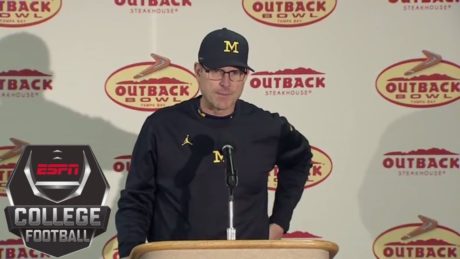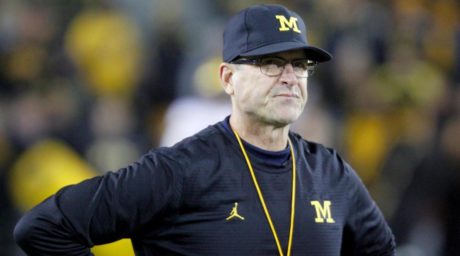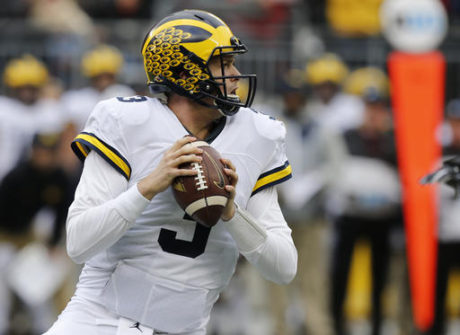
Please consider using the Amazon link/ad below to do some holiday (or regular) shopping. Thanks to those of you who do, and special thanks goes to whoever bought the $1,500 camera the other day, since the site earns a commission on sales! All contributions are appreciated.
Punched in the gut. I was nervous the whole game, but Michigan led most of the way. That was a heartbreaking way to lose, because just one play here or there could have sealed the game. I kept waiting for someone, anyone, to make a game-changing interception or forced fumble or catch-and-run or special teams play, and it just never came. The Wolverines were up 17-7 at one point, but they let that lead disappear. And in the fourth quarter and overtime, Ohio State had the right answers while Michigan flailed.
Obligatory comments about the refereeing. I’m of the school of thought that if teams want to win, they shouldn’t leave the game close enough to let the outcome be altered by referees. That being said, the refereeing was bad. Jim Harbaugh said he was “bitterly disappointed” with the officiating. It’s difficult for any team to go four quarters and two overtimes with only 2 penalties for 6 yards. The two penalties were a false start and an illegal hands to the face, the latter of which cost the Buckeyes only a yard due to the location on the field. Coming into Saturday, OSU was #57 in the country with an average of 6.5 penalties for 52.7 yards per game. They had at least 4 penalties in every game except Northwestern, when they had 2 penalties for 10 yards. A few of the egregious or noteworthy calls/non-calls:
- Ohio State CB Gareon Conley wrapped his right arm around WR Grant Perry for a pass breakup in the second overtime that should have been called.
- Ohio State CB Marshon Lattimore held WR Amara Darboh off the line of scrimmage and forced him to the ground in the first half. The ball was thrown to him and fell harmlessly to the turf, but no referee called defensive holding or pass interference. This came after a similar play on which Channing Stribling was called for P.I.
- Jim Harbaugh’s unsportsmanlike conduct penalty was questionable. I get that he shouldn’t have thrown his call sheet, and he probably said something that shouldn’t have been said. But he does something similar approximately once every week, and the referees let him do it. Now in the last week of the season, in The Game, they’re going to call it? Call that consistently, and he might tone it down. But when you let him get away with it for 11 weeks in a row, then you’ve basically condoned it.
- The Spot. On 4th-and-1 in the second overtime with Michigan up 27-24, Ohio State QB J.T. Barrett ran the ball. He was hit low by safety Delano Hill, his shoulder hit a blocker, and forward momentum that seemed bound to get him to the 15-yard line (which was the line to reach) was suddenly stopped when his body twirled in mid-air. Watching it initially, I thought the ball crossed the plane of the 15-yard line. (By the way, no measurement with the chains is necessary in that case, because the ball started on the 25-yard line, so you only have to cross the plane of the 15-yard line, kind of like scoring a touchdown. The 15-yard line is the measurement.) Upon replay, I wasn’t so sure. The ball was in Barrett’s right arm, which was trailing his left side. Ultimately, though, the referees needed irrefutable evidence that the ball didn’t get there, and no camera angles showed the ball. Either way, we’re talking about the difference of maybe 3 inches. It would take something very definitive to change the spot, and there was nothing. As a stand-alone play, I have no problem with this call. The frustrating or questionable thing is that it came at the end of a day when OSU seemed to be favored with numerous other advantages.
In case you’re wondering, Michigan was #25 in the country with 45.2 penalty yards per game on an average of 4.7 flags per game. On Saturday they had 7 for 59 yards. So Michigan had 2.3 more flags and 13.8 more penalty yards than average, while Ohio State had 4.5 fewer flags and 46.7 fewer penalty yards than average.
Michigan is mostly to blame, though, and a lot falls on the shoulders of Wilton Speight. Speight was Michigan’s best option (23/36, 219 yards, 2 TDs, 2 INTs). Even with a bum left shoulder, he was better than backup John O’Korn would have been. I commend Speight for playing just two weeks after what was reported as an A.C. separation. (I’ve had an A.C. separation, albeit in my throwing shoulder, and it’s not fun. Even if it had been in my non-throwing shoulder, playing football would have been tough.) Still, Speight’s the one who gave the Buckeyes most of their scoring opportunities. It started with a pick-six where De’Veon Smith missed a blitz pickup, but Speight compounded the problem by throwing in the middle of the field, where Malik Hooker – OSU’s most dangerous defensive back – was waiting. Then Speight fumbled on Ohio State’s 2-yard line when the Wolverines would have had a touchdown or at least an easy field goal. The last big mistake was an interception to sinking linebacker Jerome Baker, who may have been obscured by the umpire standing in front of him, but it gave Ohio State a short field to score. Toss in a couple errant throws that could have been first downs or touchdowns in the flat, and it was not a great day for Speight. He did make some plays, such as the 4th down touchdown throw to Darboh in the first overtime, but there weren’t enough. Take away the pick-six and the fumble, and conservatively, you’re looking at a two-score swing, even if you spot OSU a safety instead of the pick-six.
The play calling was poor, as well. I know there were some people who were upset with the play calling in the Iowa game – which I still have not finished watching – but this was a poorly called offensive game as well. I don’t understand running De’Veon Smith on power on 3rd-and-7 in overtime. I don’t understand having Jabrill Peppers run a zone read on 3rd-and-goal from the 7-yard line earlier in the game. I don’t understand running play action with your bum-shouldered QB where he’s repeatedly turning his back to the defense, even after the defense has figured out that you can’t run the ball. I don’t understand why Michigan wasn’t better at executing the run/play action from shotgun. Jehu Chesson touched the ball 4 times. Chris Evans got 6 carries. Eddie McDoom had 0 touches. Ty Isaac averages 5.6 yards/carry and 21 yards/catch, and he got 0 touches. Michigan went into a shell where it was Speight throwing to Jake Butt/Amara Darboh, De’Veon Smith running the ball, and a mostly uninspiring Jabrill Peppers package.
We are who we thought we were. Ultimately, even prior to the season, the downfall of Michigan’s team was what we expected it to be. Wilton Speight – shoulder notwithstanding – was a checkdown artist who didn’t take any downfield shots. Michigan’s offensive line was unable to create running lanes against a good defense. De’Veon Smith (21 carries, 60 yards, 2.9 yards/carry) is slow. Yes, those are all limitations on the offense, because the defense was pretty darn good and should have been good enough to win the game.
The defense was outstanding. Michigan allowed 330 yards of offense, which is the second lowest output for Ohio State this year (behind what they put up against Michigan State). Furthermore, if you take away the overtime production – which was approximately 45 yards – you’re talking about giving up about 285 yards to the Buckeyes in this game, which is 208 yards lower than their average this season. There were some busts by Michigan late in the game (the 15-yard game winner by Curtis Samuel, a handful of runs by J.T. Barrett), but overall, it was an excellent performance that included 13 tackles for loss and 8 sacks. There was talk that defensive coordinator Don Brown was hired because he’s a “spread killer,” and while Michigan definitely didn’t kill the spread, it was a pretty darn good performance. Speight handed Ohio State 10 points with his two interceptions, so we’re basically talking about a defense that gave up 7 points in regulation.
A few defensive kudos. A couple guys played what I thought was probably the best game of their career, and maybe there were even more than that. Taco Charlton, leg cramps and all, made 9 tackles, 3 tackles for loss, and 2.5 sacks. Backup nose tackle Bryan Mone made 3 tackles, 1 tackle for loss, and 1 pass breakup. Both of those guys had career best days, in my opinion. In last week’s awards post, I called out Mone as someone who had been underachieving, but he really showed up on Saturday. Hopefully he can carry that over into 2017 once Ryan Glasgow graduates. I also thought Glasgow (2 tackles, 1.5 TFLs, 1 sack), Ben Gedeon (10 tackles, 2 TFLs, 1 sack), and Mike McCray (9 tackles, 1 TFL, 1 sack, 1 PBU) played very well. I’ve been very critical of Channing Stribling’s tackling, but he was ready to play against OSU and finished with 4 tackles, 2 TFLs, 1 sack, and 1 very nice pass breakup.
A few defensive questions. The defense played extremely well, but as is bound to happen against Ohio State, there were some major goofs. I counted at least three times that Michigan played two defensive backs over the trips side, and all three plays resulted in completions for Barrett. The last was an inexplicably easy completion to Noah Brown in the fourth quarter, so it wasn’t something that happened early and got fixed. Michigan also had several communication issues, even when they weren’t getting beaten by tempo. A late long run by Barrett occurred when Michigan had no linebackers in the box except for Peppers, who was lazily spying about 7 yards off the ball. And on the final play, a blitz by Mike McCray seemed to open up a running lane for Curtis Samuel. I think McCray would have been in the hole to at least slow down Samuel if he hadn’t been blitzing, but no fewer than three (3!!!) defenders seemed to book it for outside contain, which made it a very easy cut for Samuel. When three guys overpursue and another guy takes himself out of the play by blitzing inside, you’ve got a pretty good shot at making something happen.
It was not the best day for Jabrill Peppers or his coaches. I expected and hoped for more from Peppers. He is probably headed for the NFL after this season, but it’s too soon for a career retrospective with a bowl game yet to be played. Statistically, he had a decent day on his two primary focuses, defense and special teams: 7 tackles, 1 interception returned for 11 yards, 1 punt return for 5 yards, and 1 kickoff return for 44 yards. But I couldn’t help feeling like he wasn’t quite all there on Saturday. His feet seemed to be stuck in mud at times. Ohio State TE Marcus Baugh had 2 catches against Peppers, and I would be okay with that if it was because he got outmuscled or outjumped, but on both plays, it was because Peppers was just slow to react. Peppers was also spying Barrett when the QB took off late in the game, and Peppers – a high school state champion sprinter – couldn’t make up ground on the 6’2″, 222 lb. QB who many describe as not being particularly fast, but instead shifty and tough with good vision. I don’t know if he was tired or nursing some sort of injury, but he wasn’t the ball of energy I’m used to seeing. As for his coaches, I thought his offensive usage was pretty horrendous. He had 4 carries for 4 yards, and that’s with his first carry going for 6 yards (hint: his next 3 carries went for -2 yards). The best play was using him in the backfield, faking a toss sweep to him, and then bootlegging Speight for a completion to Darboh. Michigan should have used him more as a decoy, they could have used him in the slot, they could have run a reverse or a jet sweep, they could have lined him up at QB and had him fake a zone read then throw the ball, etc. Instead, his entire offensive usage was, if I remember correctly: 3 quarterback powers, 2 zone reads (including 1 handoff to De’Veon Smith), and 1 snap as a decoy at RB. You’ve got one of the most dynamic players in the country, a potential Heisman candidate, and a future 1st round pick, and that’s all you can come up with for the biggest game of the year? Additionally, as mentioned earlier, the 3rd-and-goal zone read was a terrible play call, because the defense knows he’s not going to throw the ball and he’s going to try to keep it to score a TD.
I’m more disappointed than I thought I would be. Keep in mind that I picked Michigan to lose this game in the pre-season, and I called for a 21-17 loss in the game preview (if Speight played, which obviously he did). That was a pretty damn good prediction, considering OSU was on the brink of going up 21-17 in the final seconds of regulation. I have been expecting a similar outcome for months. But I can’t help thinking Michigan let this one slip through their fingers. The Buckeyes only led in this game for 3 minutes and 58 seconds of regulation. I didn’t expect the Iowa loss and picked an 11-1 season. Even a 10-2 season isn’t bad, but it could have been so much better. The Wolverines lost to Iowa by 1 point with no time left on the clock, and they were beating Ohio State by 3 points until there was 1 second left on the clock. The Wolverines lost two games by razor-thin margins, and instead of a potential Big Ten championship and playoff seed, they’ll be waiting to hear about a pretty good bowl bid.

